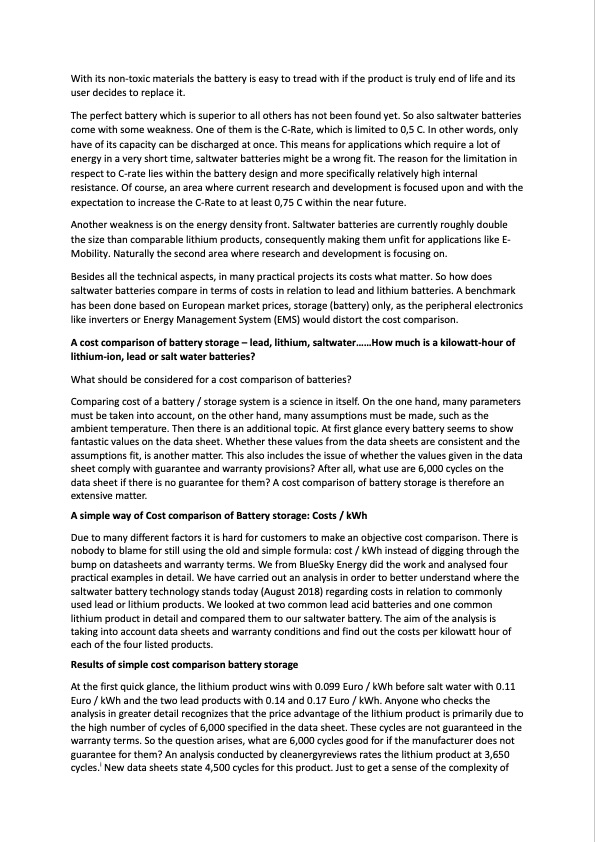
PDF Publication Title:
Text from PDF Page: 002
With its non-toxic materials the battery is easy to tread with if the product is truly end of life and its user decides to replace it. The perfect battery which is superior to all others has not been found yet. So also saltwater batteries come with some weakness. One of them is the C-Rate, which is limited to 0,5 C. In other words, only have of its capacity can be discharged at once. This means for applications which require a lot of energy in a very short time, saltwater batteries might be a wrong fit. The reason for the limitation in respect to C-rate lies within the battery design and more specifically relatively high internal resistance. Of course, an area where current research and development is focused upon and with the expectation to increase the C-Rate to at least 0,75 C within the near future. Another weakness is on the energy density front. Saltwater batteries are currently roughly double the size than comparable lithium products, consequently making them unfit for applications like E- Mobility. Naturally the second area where research and development is focusing on. Besides all the technical aspects, in many practical projects its costs what matter. So how does saltwater batteries compare in terms of costs in relation to lead and lithium batteries. A benchmark has been done based on European market prices, storage (battery) only, as the peripheral electronics like inverters or Energy Management System (EMS) would distort the cost comparison. A cost comparison of battery storage – lead, lithium, saltwater......How much is a kilowatt-hour of lithium-ion, lead or salt water batteries? What should be considered for a cost comparison of batteries? Comparing cost of a battery / storage system is a science in itself. On the one hand, many parameters must be taken into account, on the other hand, many assumptions must be made, such as the ambient temperature. Then there is an additional topic. At first glance every battery seems to show fantastic values on the data sheet. Whether these values from the data sheets are consistent and the assumptions fit, is another matter. This also includes the issue of whether the values given in the data sheet comply with guarantee and warranty provisions? After all, what use are 6,000 cycles on the data sheet if there is no guarantee for them? A cost comparison of battery storage is therefore an extensive matter. A simple way of Cost comparison of Battery storage: Costs / kWh Due to many different factors it is hard for customers to make an objective cost comparison. There is nobody to blame for still using the old and simple formula: cost / kWh instead of digging through the bump on datasheets and warranty terms. We from BlueSky Energy did the work and analysed four practical examples in detail. We have carried out an analysis in order to better understand where the saltwater battery technology stands today (August 2018) regarding costs in relation to commonly used lead or lithium products. We looked at two common lead acid batteries and one common lithium product in detail and compared them to our saltwater battery. The aim of the analysis is taking into account data sheets and warranty conditions and find out the costs per kilowatt hour of each of the four listed products. Results of simple cost comparison battery storage At the first quick glance, the lithium product wins with 0.099 Euro / kWh before salt water with 0.11 Euro / kWh and the two lead products with 0.14 and 0.17 Euro / kWh. Anyone who checks the analysis in greater detail recognizes that the price advantage of the lithium product is primarily due to the high number of cycles of 6,000 specified in the data sheet. These cycles are not guaranteed in the warranty terms. So the question arises, what are 6,000 cycles good for if the manufacturer does not guarantee for them? An analysis conducted by cleanergyreviews rates the lithium product at 3,650 cycles.i New data sheets state 4,500 cycles for this product. Just to get a sense of the complexity ofPDF Image | new generation of saltwater batteries

PDF Search Title:
new generation of saltwater batteriesOriginal File Name Searched:
Dr-Thomas-F-Krausse-BlueSky-Energy-paper.pdfDIY PDF Search: Google It | Yahoo | Bing
Product and Development Focus for Salgenx
Redox Flow Battery Technology: With the advent of the new USA tax credits for producing and selling batteries ($35/kW) we are focussing on a simple flow battery using shipping containers as the modular electrolyte storage units with tax credits up to $140,000 per system. Our main focus is on the salt battery. This battery can be used for both thermal and electrical storage applications. We call it the Cogeneration Battery or Cogen Battery. One project is converting salt (brine) based water conditioners to simultaneously produce power. In addition, there are many opportunities to extract Lithium from brine (salt lakes, groundwater, and producer water).Salt water or brine are huge sources for lithium. Most of the worlds lithium is acquired from a brine source. It's even in seawater in a low concentration. Brine is also a byproduct of huge powerplants, which can now use that as an electrolyte and a huge flow battery (which allows storage at the source).We welcome any business and equipment inquiries, as well as licensing our flow battery manufacturing.| CONTACT TEL: 608-238-6001 Email: greg@salgenx.com | RSS | AMP |